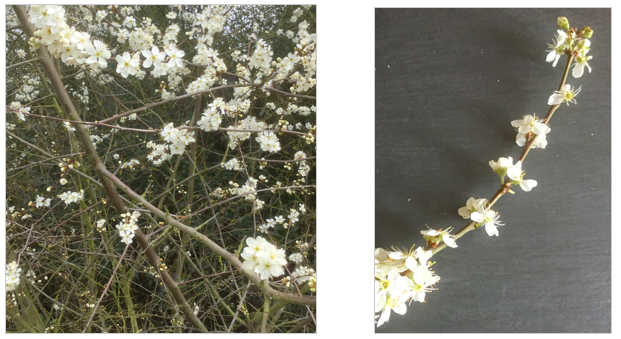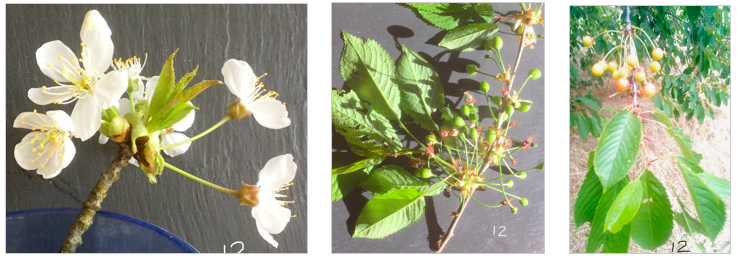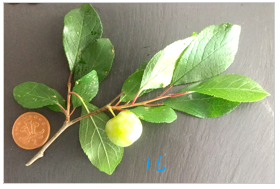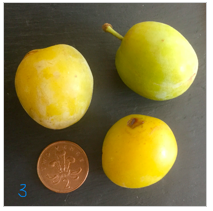Cherries and Plums both belong to the genus Prunus in the Rose family (Rosacaea). They are prized for their delightful blossom, edible fruit (not forgetting the many delicious liqueurs made from cherries and plums) and decorative wood. Also they are highly valued for providing shelter and food for wildlife: - leaves for larva; nectar and pollen for butterflies and bees; fruit for birds and small mammals. At Ham we are lucky to have a wonderful succession of blossoms to enjoy from early March to May, and from August, the possibility of foraging for fruit.
How do cherries and plums differ?
This is easy in greengrocers but not so straight forward in nature. In plums the young leaves unroll; the flowers are usually borne individually, on relatively short stalks; the fruit stone is flattened; the winter twigs do not have a bud at the very tip. In cherries the young leaves are folded; 2 or more flowers are bunched together by chaffy scales on longer stalks; the fruit stones are round; the winter twigs have a bud at the very tip. However, the Cherry Plum, as the name suggests, is intermediate in some respects although it is classed as a plum. Sloes are also grouped with plums. The different species (kinds) of Prunus are variable and hybrids can occur, this can sometimes make identification tricky.
Flowering times
The flower buds of our different species open in succession. As well as giving us longer to appreciate the blossoms, this offers a clue to their identity. These are the species of Prunus that can be found on the Ham Lands in order of flowering (but may well be earlier due to global warming).
March - April
P. cerasifera, Cherry-plum or Myrobalan
Naturalised and very common on the Ham Lands. Small trees, occasionally with suckers and sometimes with spines. The young twigs are often green, at least on the underside and not hairy. A few trees with bronze tinged foliage can be found on the Ham Lands. The lightly almond scented flowers open before the leaves or with them, they are borne singly and have white petals (but pink forms also occur). The fruits are yellow, sometimes with orange streaks or light red and they lack bloom.
It is thought that fruit infrequently develops in the UK because the flowers open so early that few pollinators are available and there is danger of frost damage. However, as we have many young saplings, fruiting would seem to be not such a rare occurrence. Cherry-plums are quite variable, especially flower size and length of flower stalk. The planted specimens (by Thames Mariner’s entrance and towards the Hawker Centre, Kingston) have larger often pink flowers on longer stalks. Several cultivated varieties of myrobalan have very dark reddish or copper-coloured leaves.
Mirabelle Plums v Cherry Plums
Some authorities say the Mirabelle is a cultivated variety of P. cerasifera, while others suggest that it is a form of plum, P. domestica subsp. cerea (= syriaca) or even a sweet form of Bullace. The delicious yellow or red plums planted near the Thames Young Mariners entrance strongly suggest our plants to be a form of Cherry Plum. They frequently bear plenty of fruit but can sometimes be disappointing.
March - May
Prunus spinosa, Blackthorn or Sloe
A native strongly suckering bush forming several dense spiny thickets on Ham Lands north. The solitary, small white flowers appear before the leaves. The small astringent, blue-black fruits have a characteristic bloom. This species is especially variable. Unfortunately for lovers of sloe gin our bushes produce very few sloes, but some near the Hawker Centre (Kingston) are usually more productive. Blackthorn’s role in supporting wildlife is especially valuable as it provides both food and shelter. In particular it is vital for Brown and Black Hairstreak butterflies.
April - May
Prunus avium, Wild Cherry or Gean
The poet A. E. Houseman’s ‘loveliest of trees’. Native: plentiful on both Ham Lands North and South, often forming groves. These Cherries grow into tall trees with very attractive silky, reddish bark; they readily produce suckers but lack spines. Large reddish glands can be found at the top of the leaf stalk. The cup-shaped flowers are borne with, or slightly before, the leaves in bunches of 2-6; the white petals are often notched at the top and narrow towards the base. The small sized fruit is bright red but can later turn blackish, they lack bloom. Many varieties of dessert cherries were cultivated from this species.
Prunus cerasus, Sour or Dwarf Cherry
Well established in the UK; a few of these cherries were planted near Locksmead. The trunks are much shorter than the Wild Cherry and the twigs tend to hang down. Also the leaves are said to be darker green and have smaller or no glands (I can not confirm this). The flower-stalks are a little shorter, the flowers saucer-shaped (as opposed to cup-shaped) and the petals are scarcely notched at the top but somewhat rounded at the base. This cherry arose as a natural hybrid (P. avium x P. fruticosa). The Morello (P. cerasus var. morasca) and Amarelle (P. var. amarena) cherries were developed from this species. Introgression through hybridisation with P. avium can make identification difficult.
Prunus domestica, Plums
It has been traditionally thought that plums are a cross between P. spinosa and P. cerasifera, but modern genetic evidence suggests they were derived only from P. cerasifera (6 X). Another opinion is that purple plums came via the hybrid route but yellow plums were developed from P. cerasifera. P. domestica has given rise to numerous cultivated varieties of plum.
P. domestica subsp. insitia (= P. insitia), Bullace (or Wild Damson)
Well established in the UK, often growing in hedgerows. The bushes form spiny thickets and the white flowers occur with the leaves. The blue-black or purple fruits usually have a bloom and are sour to taste. The English Damson (the flavour of damson jam is distinctive) is regarded as a cultivated form of Bullace. Our purple fruited plums are quite variable, some are Bullace-like while others have somewhat larger and sweeter fruit. There are several clumps on Ham Lands South.
P. domestica subsp. italica, Greengage.
This is very similar to the Bullace except that the fruit is green and spines are seldom present. The fruit is much smaller than cultivated forms. There is a good clump near the Mariner’s Base bridge.
P. domestica subsp. intermedia, Egg Plum
This strongly succering plum has larger, sweet, yellow-orange, Victoria Plum-like fruit. There is one clump on Ham Lands south.
Other Cherries You May Find at Ham
P. serrulata (= P. jamasakura, = var. spontanea), Wild Hill Cherry
Exotic: one tall, narrow tree near the BMX jumps. Flowers large, shell pink.
P. padus, Bird Cherry
Native: Planted on Riverside Drive near Katye’s Nursery. The bark has a strong almond-like smell. The small creamy flowers are grouped in long, narrow, dangling clusters; fruit black.
P. laurocerasus, Cherry-laurel
Self-seeded in woods and thickets on the Ham Lands. It may come as a surprise to learn that this common evergreen shrub with shiny, leathery leaves is classed as a cherry. The small creamy flowers are grouped in narrow, upright clusters; fruit purple-black.
What are the Strange Growths?
Pocket Plum - galls caused by a fungus Taphrina prunii (or other species). Sometimes reddish, often chilli-like growths can be found on a variety of Prunus species, just after flowering. Normal fruit can still develop at the usual time. There was a considerable, eye-catching infestation in 2019, but very little in 2020.








